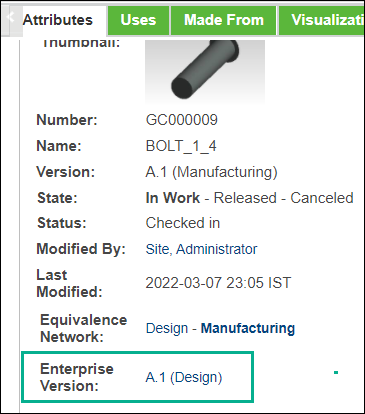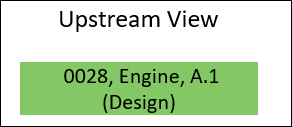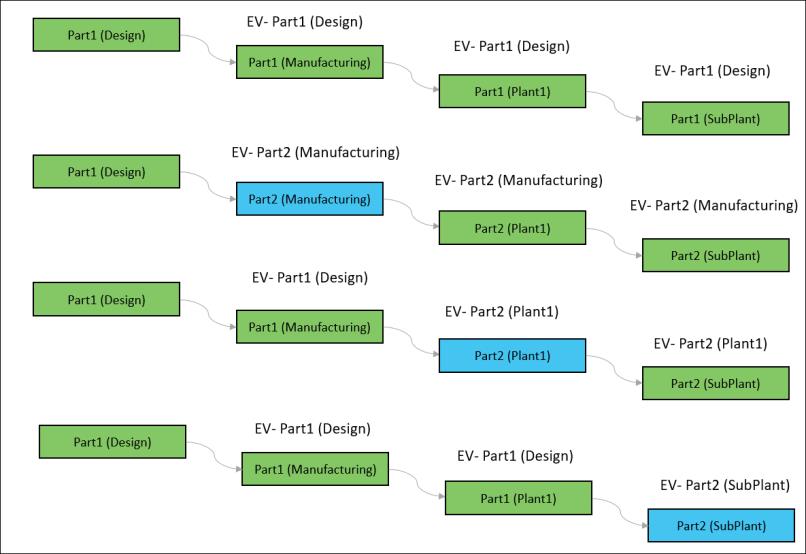Enterprise Version
Every downstream part is manufactured based on the specification of the upstream part. For a particular part, the Enterprise Version attribute displays the latest linked upstream part version.

Every part that is manufactured in an industry uses some design as a design reference. The design reference is nothing but the enterprise version. It may happen that, the design engineer updates the design. In such scenario, to manufacture the part with the latest changes, one must update the enterprise version.
Key Points
• The Enterprise Version attribute value appears as a link. If you click the link, the part information page opens.
• You can also view the Enterprise Version attribute value in the information page of parts.
• It may happen that the part master in the downstream view is different than the part master in the upstream view. In such a case, the Enterprise Version attribute value in the downstream is the same as the part master in the downstream. For more information, see Use Case 1 — Same Part Master.
In certain scenarios, the equivalent part master in the downstream is different than the part master in the upstream. For example, part masters are created in downstream using the BOM Transformation actions. In such scenarios, since it's a new part master, there is a new design associated with the part master. So the Enterprise Version attribute value is not its upstream equivalent. The Enterprise Version attribute value is same as the part in downstream. For more information, see Use Case 2— Different Part Master and Use Case 3— Different Part Masters (Multiple View Hierarchy Scenarios).
Use Cases
The Enterprise Version changes once you change the part master. The following use case provides you with an insight into the working of the Enterprise Version attribute in the BOM Transformer.
Use Case 1 — Same Part Master
Engine, A.1 (Design), present in the upstream view, and Engine, A.1 (Manufacturing) present in the downstream view are equivalent parts.
In this scenario, the value of the Enterprise Version attribute in the downstream view is A.1 (Design). The reason being, Engine, A.1 (Manufacturing) is the new branch of the part Engine, A.1 (Design), present in the upstream view. In this scenario, the part master has not changed.

Iterate Engine, A.1 (Design), present in the upstream view to Engine, A.2 (Design). The equivalent status icon displays an out-of-date icon  for Engine, A.2 (Design) and Engine, A.1 (Manufacturing).
for Engine, A.2 (Design) and Engine, A.1 (Manufacturing).
In this scenario, the value of the Enterprise Version attribute in the downstream view remains as A.1 (Design). The reason is, even though the part in the upstream view is iterated, A.1 (Design) is still the linked iteration for the part in the downstream view. That is, it refers to the older version of the design.

Initiate the Update to Current Upstream Equivalent Object action on Engine, A.1 (Manufacturing). The out-of-date icon is replaced with  . The iteration of the part changes to Engine, A.2. (Manufacturing).
. The iteration of the part changes to Engine, A.2. (Manufacturing).
In this scenario, the value of the Enterprise Version attribute in the downstream is A.2 (Design). The reason is, the system updates the linked iteration to A.2 (Design). It now refers to the latest version of the design.

Use Case 2 — Different Part Masters
Consider that the following part is present in the upstream view:

Initiate the New Downstream Part action on the part 0028, Engine, A.1 (Design) in the upstream view. The updated structure appears as follows:

In this scenario, the value of the Enterprise Version attribute in the downstream view is A.1 (Manufacturing). The reason being, the part master is changed to 0029, A.1 (Manufacturing). Whenever the part master is changed, the value of the Enterprise Version attribute is same as that of the part master.
The Enterprise Version attribute value appears as a link. If you click the link , you will be directed to the part information page of 0029, A.1 (Manufacturing) |
Business Use Case
Consider that you want to manufacture an engine. The BOM for the engine mentions that you need to consume or use 28 bolts. The entries of these bolts is mentioned in the ERP system. In order to manufacture the perfect engine, the number of bolts mentioned in the BOM and the ERP system must be the same. Also, the change in part master must be noted by the system. This is where the Enterprise Version attribute is of great help.
Use Case 3— Different Part Masters (Multiple View Hierarchy Scenarios)
Consider the following image:

The context is changed from Design to Manufacturing, Manufacturing to Plant1, and Plant1 to SubPlant.
The Enterprise Version attribute value is the same as the part master. As the part master changes, the Enterprise Version attribute value also changes.